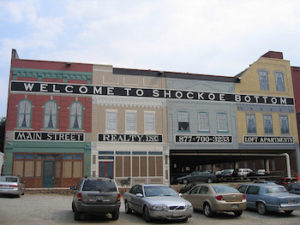
*On this date in 1983, Shockoe Bottom was placed on the National Register of Historic Places. Between the late 17th century and the end of the American Civil War in 1865, the area played a significant role in the perpetration of slavery in the United States, serving as the second-largest slave trading center in the country after New Orleans, Louisiana.
Shockoe Bottom is an area in Richmond, Virginia, just east of downtown, along the James River. Located between Shockoe Hill and Church Hill, Shockoe Bottom contains much of the land in Colonel William Mayo's 1737 plan of Richmond, making it one of the city's oldest neighborhoods. Profits from the trade and sale of Blacks fueled the creation of wealth for Southern whites and drove the economy in Richmond, leading 15th Street to be known as Wall Street in the antebellum period, with the surrounding blocks home to more than 69 slave dealers and auction houses.
Shockoe Bottom began developing in the late 18th century following the move of the state capital to Richmond. This was aided by the construction of Mayo's bridge across the James River (ultimately succeeded by the modern 14th Street Bridge) and the setting of key tobacco industry structures, such as the public warehouse, tobacco scales, and the Federal Customs House, in or near the district. Throughout the 19th Century, Shockoe Bottom was the center of Richmond's commerce, with ships pulling into port from the James River.
Goods coming off these ships were warehoused and traded in Shockoe Valley. Shockoe Bottom was a center of the Black African slave trade between 1830 and 1865. Over 400,000 slaves were traded there. The area held slave jails, auction houses, and businesses participating in the enslavement of thousands of men, women, and children. Among the most notorious places in Shockoe Bottom was Goodwin’s Jail, where Solomon Northup, whose life was chronicled in the movie, "12 Years a Slave," was held after being kidnapped.
On the eve of the fall of Richmond to the Union Army in April 1865, evacuating Confederate forces were ordered to set fire to the city's tobacco warehouses. The fires spread and destroyed Shockoe Slip and several other districts. The district was quickly rebuilt in the late 1860s, flourishing further in the 1870s and forming much of its present historic buildings. Architecturally, many buildings were constructed during the rebuilding following the Evacuation Fire of 1865, especially in a commercial variant of the Italianate style, including a 1909 fountain dedicated to "one who loved animals."
The district's buildings, which historically housed various offices and wholesale and retail establishments, are now primarily restaurants, shops, offices, and apartments. It warehoused many of the city's goods, mostly tobacco. The district began declining in the 1920s as other city areas rose in prominence with the advent of the automobile. Numerous structures would be demolished and cleared, including (in the 1950s) the Tobacco Exchange, which had been at the heart of the district.
Until they moved from Tobacco Row in the 1980s, the area was home to many of the country's largest tobacco companies. It became a central entertainment district in the last two decades of the 20th century. After centuries of periodic flooding by the James River, development was greatly stimulated by completing Richmond's James River Flood Wall and the Canal Walk in 1995. Ironically, the next flooding disaster came not from the river but from Hurricane Gaston, which brought extensive local tributary flooding along the basin of Shockoe Creek and did extensive damage to the area in 2004, with businesses being shut down and many buildings condemned.
A significant boom in residential growth was created in the mid-1990s when old warehouses in Tobacco Row were converted into apartments. Since then, more vacant buildings have been replaced with residential dwellings, and new ones have been built. In 2006, archaeological excavations began on Lumpkin's Jail's former site. Nearby is the African American Burial Ground, long used as a commercial parking lot, most recently by Virginia Commonwealth University. It was reclaimed in 2011 after a decade-long community organizing campaign and is a memorial park today. The potential development of a minor-league baseball stadium threatens Shockoe Bottom.
Shockoe Bottom’s invaluable resources of America's history cannot be seen. None of the buildings from the slave trade remain visible in these eight blocks, and the artifacts of antebellum Richmond are now below the surface, out of sight. Shockoe Bottom should be protected as a site of conscience that offers the public a chance to experience and learn from this dark chapter in American history. A path forward for Shockoe Bottom could include meaningful public involvement and expert archeological analysis so that the historical remnants of the slave trade now buried there can be seen and correctly interpreted.